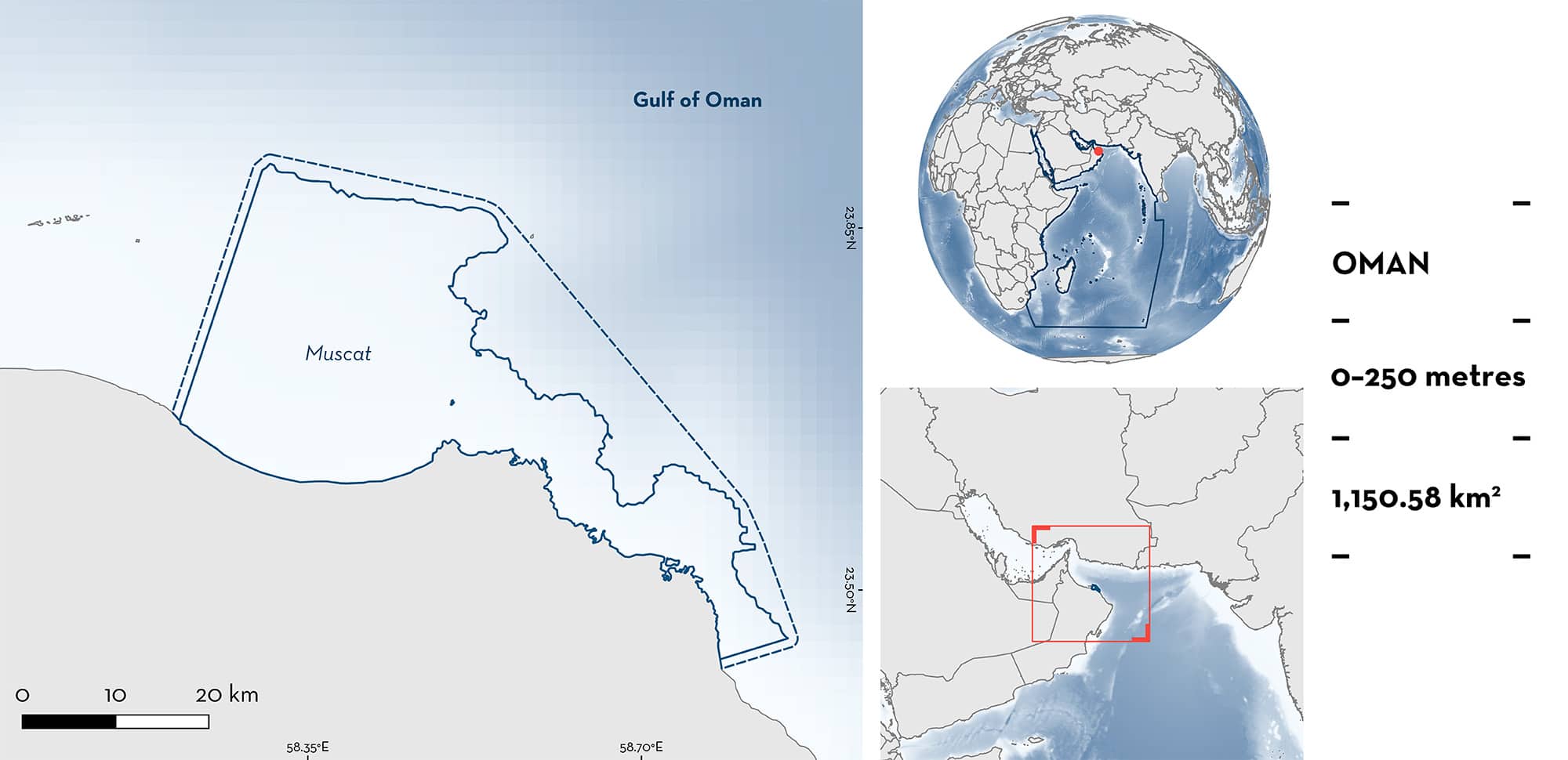ISRA FACTSHEETS
ISRA FACTSHEETS
WESTERN INDIAN OCEAN REGION
Muscat
Summary
Muscat is located on the Gulf of Oman coast in the northern part of the Sultanate of Oman. The area is characterised by a wide continental shelf and sandy bays, rocky areas, inlets, and islands. It is influenced by the southwest monsoon during the boreal summer that produces upwelling events and phytoplankton blooms. The area overlaps with two Key Biodiversity Areas. Within the area there are: reproductive areas (Bigeye Houndshark Iago omanensis).
Download factsheet
Muscat
DESCRIPTION OF HABITAT
Muscat is located on the Gulf of Oman coast in the northern part of the Sultanate of Oman. The area is characterised by a wide continental shelf (27–46 km) with sandy bays, rocky areas, inlets, and islands, such as limerock Fahl Island (Sheppard et al. 1992; Siddeek et al. 1999). The area is influenced by northeast monsoon winds during the boreal winter and the southwest monsoon during summer (AlBusaidi & Al-Hashmi 2023). Cool water advected to the area in summer produces upwelling events and phytoplankton blooms (McIlwain et al. 2011). Maximum sea surface temperatures (~32°C) occur in June/July, while minimum (~22°C) occur in February (Al-Hashmi et al. 2014; AlBusaidi & Al-Hashmi 2023).
This area overlaps with two Key Biodiversity Areas (KBA), Bandar Jussah and Fahl Island (KBA 2023a, 2023b).
This Important Shark and Ray Area is benthopelagic and is delineated from inshore and surface waters (0 m) to 250 m based on the distribution of the Qualifying Species in the area.
CRITERION C
SUB-CRITERION C1 – REPRODUCTIVE AREAS
Muscat is an important reproductive area for one shark species.
Bigeye Houndsharks were reported as the most commonly caught species in artisanal fisheries and trawlers in Muscat between 2002–2004, with almost no catches recorded in other landing sites along the coast of Oman (Henderson et al. 2004, 2007). Individuals sampled (n = 424) measured 24–84 cm total length (TL) and were mostly females (~70%). In addition, 237 individuals (31–84 cm TL) were caught on experimental longlines (100–250 m depth) in the same period (Henderson et al. 2006). From 545 females recorded on experimental longlines and landing monitoring, all except three individuals were mature. Pregnant females were observed in all seasons, with pregnancy stage advancing from autumn to spring, when the majority of females observed were at late pregnancy stages. During summer, females were also in late pregnancy stages but in lower proportions. Embryos had the largest size in spring and summer (n = 185; 11–14 cm TL) and litter size ranged between 1–24 (mean = 9) suggesting that pupping occurs in these seasons as this is the only place in Oman where pregnant females are regularly observed. Based on vertebral band counts (n = 395), 10 males (4%) were estimated to be young-of-the-year (YOY), and another 45 individuals (18%) were one-year old with most of them being mature (Henderson et al. 2004).
Between 2009–2011, this species was also the most important in monitored Muscat landings (n = 895, 55% of total shark landings), confirming the regular presence of this species and supporting the continued occurrence of reproduction in the area (Henderson & Reeve 2014). Individuals measured 14–84 cm TL (mean: 47.2 ± 10.9 [SD] cm TL), confirming the presence of YOY individuals (size-at-birth >17 cm TL, Ebert et al. 2021). No neonates were caught but this could be due to the fishing gear used that may have selected larger sizes. Muscat is the only site along the coast of Oman where pregnant females with terminal embryos and YOY have been reported, highlighting the reproductive importance of the area for Bigeye Houndsharks.
Download factsheet
SUBMIT A REQUEST
ISRA SPATIAL LAYER REQUEST
To make a request to download the ISRA Layer in either a GIS compatible Shapefile (.shp) or Google Earth compatible Keyhole Markup Language Zipped file (.kmz) please complete the following form. We will review your request and send the download details to you. We will endeavor to send you the requested files as soon as we can. However, please note that this is not an automated process, and before requests are responded to, they undergo internal review and authorization. As such, requests normally take 5–10 working days to process.
Should you have questions about the data or process, please do not hesitate to contact us.


